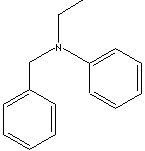PRODUCT IDENTIFICATION

202-169-8
CLASSIFICATION
PHYSICAL AND CHEMICAL PROPERTIES
REFRACTIVE INDEX
APPLICATIONS
APPEARANCE
99.0% min
SUM ORGANIC IMPURITY
1.0% max
MOISTURE
|
|
|
| ETHYLBENZYL ANILINE | ||
|
PRODUCT IDENTIFICATION |
||
| CAS NO. | 92-59-1 |
|
| EINECS NO. |
202-169-8 | |
| FORMULA | C6H5N(CH2C6H5)C2H5 | |
| MOL WT. | 211.31 | |
| H.S. CODE | 2921.42 | |
| TOXICITY | ||
| SYNONYMS | Phenylethylbenzylamine; | |
| Benzylethylphenylamine; n-Ethyl-n-Phenylbenzylamine; n-Ethylbenzylaniline; n-Ethyl-n-Phenylbenzenemethanamine | ||
| SMILES |
|
|
|
CLASSIFICATION |
|
|
|
PHYSICAL AND CHEMICAL PROPERTIES |
||
| PHYSICAL STATE | Pale Yellow to brown Oily Liquid | |
| MELTING POINT | 34 - 36 C | |
| BOILING POINT | 285 C | |
| SPECIFIC GRAVITY |
| |
| SOLUBILITY IN WATER | 0.1g/100 ml at 22 C | |
| AUTOIGNITION | ||
| VAPOR DENSITY | ||
| pH |
| |
| REFRACTIVE INDEX |
| |
| NFPA RATINGS |
| |
| FLASH POINT |
| |
| STABILITY | ||
|
APPLICATIONS |
||
| One of the most important aromatic amines is aniline; pale brown liquid boiling at 184 C, melting at -6 C. Aniline is obtained commercially from chlorobenzene by heating with ammonia in the presence of copper catalyst or from a product of coal tar (nitrobenzene) through the reduction reaction. Aniline is the starting material in the dye manufacturing industry and as in the manufacture of others. Aniline is converted into sulfanilic acid which is the parent compound of the sulfa drugs. Aniline is also important in the manufacture of rubber-processing chemicals, antioxidants and varnishes. Ethylbenzylaniline is used as ab intermediate for Dyes ( Acid, Food ) and other organic products | ||
| SALES SPECIFICATION | ||
|
APPEARANCE |
Pale Yellow to Brown Liquid turns to darken on exposure to air and light | |
| PURITY |
99.0% min | |
|
SUM ORGANIC IMPURITY |
1.0% max | |
|
MOISTURE |
0.1% max | |
| TRANSPORTATION | ||
| PACKING | 200 Kg in Drum | |
| HAZARD CLASS | ||
| UN NO. | ||
| OTHER INFORMATION | ||
| Hazard Symbols: XN, Risk Phrases: 20/21/22, Safety Phrases: 36/37 | ||
|
|
|